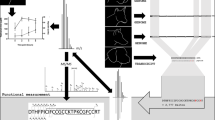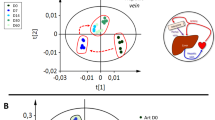Abstract
CRUSTACEAN blood is generally considered to function as a transport medium for low molecular weight metabolites. Conversely, the hepatopancreas has been regarded as a liver analogue—the principal site for the storage and metabolism of fats and carbohydrates1. It now seems likely that the blood tissue is as important as the hepatopancreas for the storage and metabolism of polysaccharides.
This is a preview of subscription content, access via your institution
Access options
Subscribe to this journal
Receive 51 print issues and online access
$199.00 per year
only $3.90 per issue
Buy this article
- Purchase on Springer Link
- Instant access to full article PDF
Prices may be subject to local taxes which are calculated during checkout
Similar content being viewed by others
References
Vonk, H. J., Physiology of the Crustacea (edit. by Waterman, T. H.), 1, Ch. 8 (Academic Press, New York and London, 1960).
Stahl, E., and Kaltenback, U., Thin Layer Chromatography (edit. by Stahl, E.), Ch. L (Academic Press, New York and London, 1965).
du Bois, M., Gilles, K. A., Hamilton, J. K., Rebers, P. A., and Smith, F., Anal. Chem., 28, 350 (1956).
Johnston, M. A., and Fisher, F. M., Biol. Bull. Mar. Biol. Lab., Woods Hole, 135, 424 (1968).
Pearse, A. G. E., Histochemistry, Theoretical and Applied (Churchill, London, 1960).
Author information
Authors and Affiliations
Rights and permissions
About this article
Cite this article
JOHNSTON, M., DAVIES, P. & ELDER, H. Possible Hepatic Function for Crustacean Blood Cells. Nature 230, 471–472 (1971). https://doi.org/10.1038/230471a0
Received:
Revised:
Issue Date:
DOI: https://doi.org/10.1038/230471a0
This article is cited by
-
Reproductive activities in the sesarmid crab Sesarma intermedia in the coastal and estuarine habitats of Hakata, Japan
Marine Biology (1986)
-
Metabolic disposition of lactate in the horseshoe crab Limulus polyphemus and the stone crab Menippe mercenaria
Marine Biology (1986)
-
Etude cytochimique des hémocytes des crustacés décapodes brachyoures
Histochemistry (1975)
-
Feeding, starvation and metabolic rate in the shore crab Carcinus maenas
Marine Biology (1973)
Comments
By submitting a comment you agree to abide by our Terms and Community Guidelines. If you find something abusive or that does not comply with our terms or guidelines please flag it as inappropriate.



